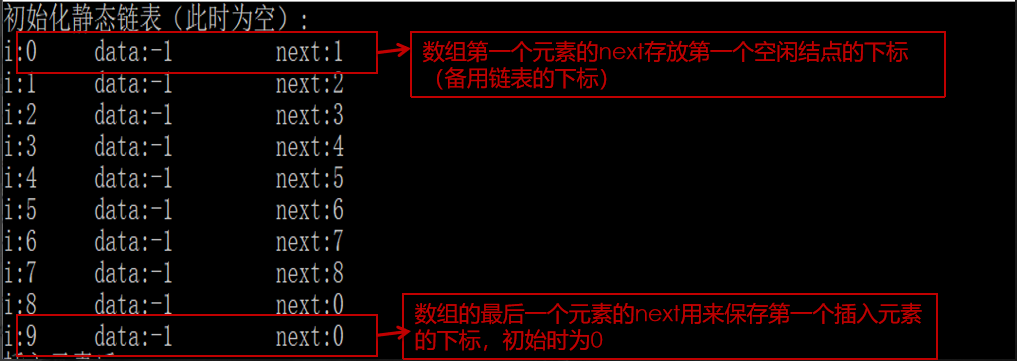Static linked list
You can use arrays instead of pointers to describe linked lists. Each element of the array is made up of data and cursor. The cursor is equivalent to the next pointer of the linked list. The linked list described by array is called static linked list, and the description method is called cursor implementation method.
The first and last elements of the array do special processing and do not store data.
The cursor of the first element of the array stores the subscript of the first free node (the subscript of the standby linked list). The cursor of the last element of the array is used to store the subscript of the first inserted element, initially 0, which is equivalent to the head node.
In order to make it easy to understand, next is used to represent cursor in figure and code
Initial state of static linked list:

Insert an element:

Insert another element:

Insert another element 30. There are three elements in the static list. Delete element at position 2 (i.e. element with subscript 1):

The code is as follows:
#include <iostream>
#include <stdio.h>
#include <stdlib.h>
using namespace std;
#define MAX_SIZE_SSL 10
#define OK 1
#define ERROR 0
typedef int ElemType;
/**
* A static linked list is an array of structures
* The next of the first element of the array stores the subscript of the first free node (subscript of the standby list)
* The next of the last element of the array is used to save the subscript of the first inserted element, which is initially 0
*/
typedef struct{
ElemType data; //Data domain
int next; // int cursor; cursor, if 0, no point
}staticLinkList[MAX_SIZE_SSL];
void InitStaticLinkList(staticLinkList slList)
{
//The next of each element points to the subscript that holds the next element
for(int i = 0;i < MAX_SIZE_SSL;i++)
{
slList[i].next = i+1;
slList[i].data = -1; // It is used to represent idle nodes when outputting
}
//Leave the last node empty
slList[MAX_SIZE_SSL-1].next = 0;
//Set the tail node of the spare list to 0
slList[MAX_SIZE_SSL-2].next = 0;
}
void OutPut(staticLinkList slList)
{
for(int i = 0;i < MAX_SIZE_SSL;i++)
{
cout << "i:" << i << "\tdata:" << slList[i].data << "\t\tnext:"<< slList[i].next << endl;
}
}
/*Allocate one unit of memory for the static linked list, i.e. find the first free node*/
int MallocSSL(staticLinkList slList)
{
//Get the subscript of the first free node (spare list)
int cursor = slList[0].next;
if(cursor)
{
slList[0].next = slList[cursor].next;
}
return cursor;
}
/*Reclaims the space of the specified subscript in the original array*/
void FreeSSl(staticLinkList slList,int index)
{
//Reclaim the free node with index as its subscript to the standby linked list
slList[index].next = slList[0].next;//The node to be released becomes the first node of the standby list, the prefix node of the original first idle node
slList[index].data = -1;
slList[0].next = index;//Update the first free node
}
int GetStaticLinkList(staticLinkList slList)
{
int count = 0;
int cursor = slList[MAX_SIZE_SSL-1].next;//First element found
while(cursor)
{
//Equivalent to P = P - > next;
cursor = slList[cursor].next;
count ++;
}
return count;
}
int InsertStaticLinkList(staticLinkList slList,int pos,ElemType element)
{
if(pos < 1||pos > GetStaticLinkList(slList)+1)
return ERROR;
int cursor = MAX_SIZE_SSL - 1;//Get the subscript of the first element
//Allocated memory
int newIndex = MallocSSL(slList);
if(newIndex)
{
slList[newIndex].data=element;
//Find that the prefix node of newIndex is the one before pos
for(int i = 1;i <= pos-1;i++)
cursor = slList[cursor].next;
slList[newIndex].next = slList[cursor].next;
slList[cursor].next = newIndex;
return OK;
}
return ERROR;
}
int DeleteStaticLinkList(staticLinkList slList,int pos)
{
if(pos < 1 || pos > GetStaticLinkList(slList))
return ERROR;
int cursor = MAX_SIZE_SSL-1; //Get the subscript of the first node
for(int i = 1;i < pos-1;i++)//Get the prefix node to delete
{
cursor = slList[cursor].next;
}
int delIndex = slList[cursor].next;//To delete the subscript of a node
slList[cursor].next = slList[delIndex].next;
FreeSSl(slList,delIndex);
return OK;
}
int main()
{
staticLinkList slList;
cout << "Initialize static list (empty at this time):\n";
InitStaticLinkList(slList);
OutPut(slList);
InsertStaticLinkList(slList,1,10);
cout << "After inserting an element 10:\n";
OutPut(slList);
InsertStaticLinkList(slList,2,20);
cout << "Then insert an element 20:\n";
OutPut(slList);
cout << "After inserting an element 30:\n";
InsertStaticLinkList(slList,3,30);
OutPut(slList);
cout << "Delete element at position 2:\n";
DeleteStaticLinkList(slList,2);
OutPut(slList);
return 0;
}

